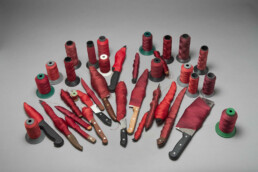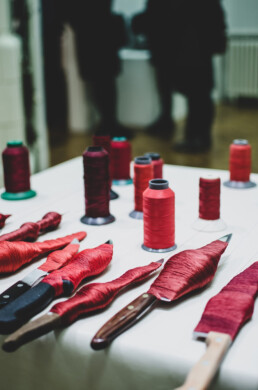OLIVERA PARLIĆ KARAJANKOVIĆ (1971)
Threadwork
group of objects on the table, artificial leather, spools of filament thread, 20 knives
90 cm x 120 cm x 70 cm
2008–2012
Threadwork
group of objects on the table, artificial leather, spools of filament thread, 20 knives
90 cm x 120 cm x 70 cm
2008–2012
“The work Threadwork is an attempt to answer the questions of what I am doing; what we, people, are doing; whether there is a common determinant of our activities, and what is the most important one; how to explain yourself to yourself, but also to others through what you do. The common denominator of these activities most often is their neurotic character: endless repetition of unsuccessful, meaningless procedures. It is not a novelty that something is wrong in the world and that we are involved in multiplying these errors.”
She participated in the 44th and 55th October Salons.
“The installation consists of a large number of knives whose blades are wrapped in numerous layers of red thread in various shades of red. The layers of thread are thick, sometimes covering the entire knife, not just the blade, becoming autonomous abstract forms that remain attached to the spools. Here and there, a pair of knives is tied together with red threads, revealing their relationship to us. We are witnessing an interrupted process, as if what is essential has already taken place, and we only see the traces of the event: an unusual collection of instruments for needlework. The ambivalence of the forms and relationships makes it impossible to determine the direction in which this process takes place: whether the blades are being uncovered and returned to their purpose, or it is about nullifying the function of the blade. There is no correct answer. The surface of the table with objects placed on it is like a stage left by the participants after the play. The resulting objects are merely a consequence; the performative process that preceded it is the focus of the work. The function of the objects and their usefulness are pushed aside in favour of a pure aesthetic experience, but they still speak: a tool, a knife blade, it is always a challenge to act against.
The process through which I came to the form of the objects in this work was long and delicate. The winding/unwinding movements often bring the blade dangerously near to the skin; injuries are inevitable, and yet I am not giving up. The movements are almost hypnotic and ritualistic, seductive and dangerous, though repetitive, they are never mechanical; they are always performed in deep concentration. These are my two hands: one precisely draws a delicate tissue with a red thread and the other, armed with a knife, sometimes makes a drawing on the back of my hand, with the blade. And although the resulting objects point to the process, they tell us little about the risk to which the hand was exposed; the beauty of the functionless object remains as a trace.”
Olivera Parlić Karajanković
© Cultural Centre of Belgrade, October Salon Collection and the artist
Purchase Contract: III-5-382/16.11.2016.
Inventory No. 1450
Photo: Courtesy the artist, installation view Pančevo, Tanja Drobnjak
ABOUT THE AUTHOR:
Olivera Parlić Karajanković (1971, Belgrade, Serbia) graduated in sculpture (1997) and received a master’s degree (2000) from the Faculty of Fine Arts in Belgrade. In 2014 she earned a doctoral degree from the Faculty of Fine Arts in Belgrade for her art project The Eros of Impossible Encounters, a sculptural form of objectified feelings. In 2005 she started working as an assistant lecturer at the Sculpture Department of the Faculty of Fine Arts and currently is an assistant professor.
Since 1997 she has presented her work in the country and abroad at numerous solo exhibitions and at the October Salon (in 2003 and 2005). She took part in the project (Out) of the Styria Institute for Art in Public Spaces, Graz, Austria, within the Styria Autumn 2009; her work was included in the exhibition A Journey Through Contemporary Serbian Art, at the China Art Museum in Shanghai in 2017. She participated in residency programmes in Ečka and Jalovik, the Terra International Art Colony in Kikinda, Air Hotel Pupik in Austria, Ada Sculpture Colonies on Ada Ciganlija, art colonies in Sićevo and Vlasina, Marble and Sounds Art Festival.
Her sculpture Čun-Pun is placed in the public space on Ada Ciganlija. She won the FLU Award for Portrait and the Sreten Stojanović Award for sculpture.
A significant part of her work has been realized within the Third Belgrade Independent Art Association, since its foundation in 2010.

